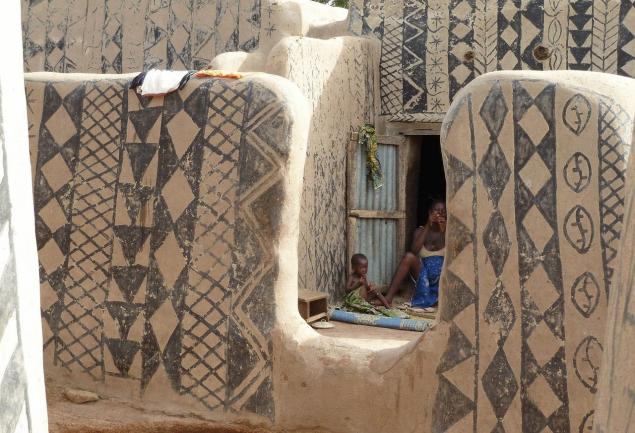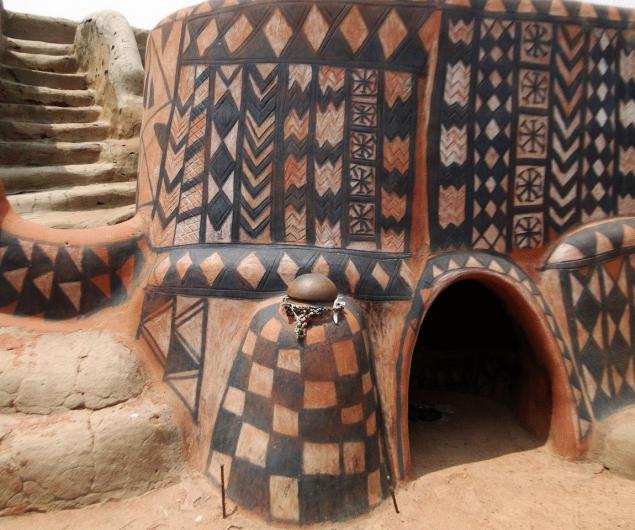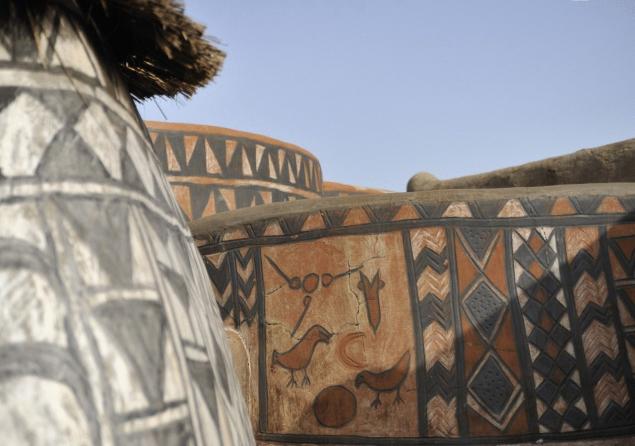The village in which the house of dirt
 Bashny.Net
Bashny.Net
In southern Burkina Faso, a country without a single landlocked country in West Africa, not far from the border with Ghana, is a small, circular village of about 1.2 hectares, called it Tiebele. It's people's homes Cassin, one of the oldest ethnic groups that began to dwell in the territory of Burkina Faso in the XV century.

The village is known for its amazing and for nothing like the traditional architecture of Gurunsi unusual and vibrantly-painted walls of houses. Burkina Faso is a very poor country even by West African standards, and probably the poorest in the world. But it is rich in terms of cultural heritage, and the decoration of the walls of their buildings is an important part of cultural life in this area. Wall decoration is done by women and girls gathering groups, this is a very ancient tradition belonging to the sixteenth century ad

Cassin people build their houses entirely of grass materials: earth, timber and straw. Soil, mixed with straw and excrement of cattle, moistened and brought to plasticity, to form a nearly vertical flat surface. Today, this traditional technique is replaced by square bricks out of clay. Building Tiebele made for protective purposes, the climate, or any potential enemies barging in unexpectedly. The wall thickness of one foot was designed with no Windows, except for small holes to let in some sunlight and indoor light. The front door is approximately two feet in height made very reliable.

After the construction of the woman makes murals on the walls using just mud and white chalk. Motifs, themes and characters taken from everyday, ordinary life, or of religion and faith. When the work is finished, the wall is carefully polished stones, each color is polished separately so that they are not mixed together. And then the whole surface is covered with a natural varnish made from legumes. The decoration was traditionally done just before the rainy season and protect walls from rains and winds. Adding cow dung, compacting layers of mud, burnishing the final layer, and varnishing, they made them resistant to wet weather and is more durable.

Source: /users/117

The village is known for its amazing and for nothing like the traditional architecture of Gurunsi unusual and vibrantly-painted walls of houses. Burkina Faso is a very poor country even by West African standards, and probably the poorest in the world. But it is rich in terms of cultural heritage, and the decoration of the walls of their buildings is an important part of cultural life in this area. Wall decoration is done by women and girls gathering groups, this is a very ancient tradition belonging to the sixteenth century ad

Cassin people build their houses entirely of grass materials: earth, timber and straw. Soil, mixed with straw and excrement of cattle, moistened and brought to plasticity, to form a nearly vertical flat surface. Today, this traditional technique is replaced by square bricks out of clay. Building Tiebele made for protective purposes, the climate, or any potential enemies barging in unexpectedly. The wall thickness of one foot was designed with no Windows, except for small holes to let in some sunlight and indoor light. The front door is approximately two feet in height made very reliable.

After the construction of the woman makes murals on the walls using just mud and white chalk. Motifs, themes and characters taken from everyday, ordinary life, or of religion and faith. When the work is finished, the wall is carefully polished stones, each color is polished separately so that they are not mixed together. And then the whole surface is covered with a natural varnish made from legumes. The decoration was traditionally done just before the rainy season and protect walls from rains and winds. Adding cow dung, compacting layers of mud, burnishing the final layer, and varnishing, they made them resistant to wet weather and is more durable.

Source: /users/117
Tags
construction
architecture and design
Burkina Faso
tiebele
people's homes Cassin
long-standing ethnic groups
country
countries in West Africa
architecture
gurunsi
decorated the walls of houses
See also
Stacking Green house garden from Vietnamese architects
Residential units in Morocco
Writer's Studio – forest Studio for a writer in new York
The transformation of the old mill
In late October, the Earth's population will increase to 7 billion
10 facts that prove that people who have a mess at home - the best of us!
Why people whose home eternal chaos - the best of us
Amazing eco-hotel in the Sahara
Art Studio exists in harmony with nature
Library project for Daegu city from Semyon Bolotnik
















